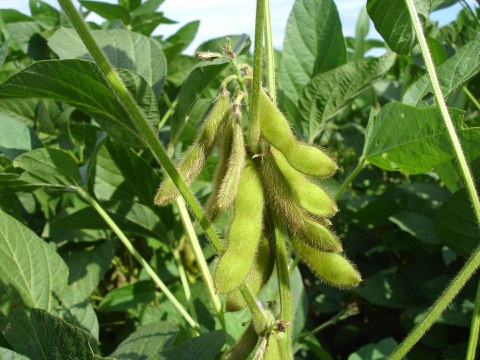25.06.2020
Biologisch aktive Naturstoffe für den Kampf gegen Krebs

Sojapflanzen produzieren Glyceolline als Immunantwort auf den Angriff von Krankheitserregern wie Pilze, Bakterien oder UV-Bestrahlung, um so ihre Gesundheit aufrecht zu erhalten.
Phytoalexine sind biologisch aktive sekundäre Pflanzenstoffe, die in den letzten Jahren aufgrund ihrer gesundheitsfördernden Wirkung beim Menschen und ihrer Bedeutung für die Pflanzengesundheit viel Aufmerksamkeit erregt haben. Chemiker der TU Dresden haben nun einen neuen und sehr effizienten Syntheseweg für diese Stoffe entwickelt. Mit der neuen Methode ebnen sie den Weg für eine einfachere Herstellung von Phytoalexinen und somit für großangelegte Untersuchungen bezüglich deren Wirkung, insbesondere hinsichtlich ihres positiven Einflusses bei der Bekämpfung von Krebserkrankungen.
Durch eine ausgewogene Ernährung nehmen wir tagtäglich größere Mengen an Phytoalexinen auf – ganz natürlich und gesund. Phytoalexine (gr. phytos = Pflanze, alekein = „abwehren“) sind sekundäre Pflanzenstoffe, die die Pflanzen als Immunantwort auf bestimmte Reize bilden, um die eigene Gesundheit aufrecht zu erhalten. Zahlreiche wissenschaftliche Studien haben bereits gezeigt, dass diese biologisch aktiven Naturstoffe auch eine gesundheitsfördernde Wirkung bei Menschen zeigen. Für die genaue Untersuchung der Wirkungsmechanismen ist jedoch eine einfache Gewinnung der einzelnen Phytoalexine wichtig, die bisher noch wenig effizient und unter Nutzung giftiger Stoffe erfolgt.
Dr. Philipp Ciesielski und Prof. Peter Metz von der Professur für Organische Chemie I der TU Dresden haben nun in der renommierten Fachzeitschrift Nature Communications einen neuartigen und äußerst effizienten Syntheseweg für Phytoalexine vorgestellt. Insbesondere die stufenarme Synthese der Phytoalexine Glyceollin I und Glyceollin II, welche als Teil der Immunantwort in Sojapflanzen gebildet werden, ist eine entscheidende Innovation. Diese zwei Naturstoffe zeichnen sich durch ein breites Spektrum an Bioaktivitäten aus, darunter die krebsbekämpfende Wirkung und gesundheitsfördernde, antioxidative und anticholesterinämische Effekte gegen westliche Krankheiten.
Die bisherigen Synthesen von Glyceollin I und II verwenden im Schlüsselschritt große Mengen des sehr giftigen und teuren Oxidationsmittels Osmiumtetroxid sowie große Mengen eines vergleichsweise teuren Hilfsstoffs als Ligand. Der neu vorgestellte Syntheseweg hingegen kommt ohne Osmiumtetroxid aus und erweist sich gleichzeitig als deutlich effizienter.
„Unser Syntheseweg zu verschiedenen Phytoalexinen ermöglicht nun einen leichteren Zugang zu diesen Substanzen. Dies ist eine wichtige Basis für weitergehende Untersuchungen zur biologischen Aktivität dieser Naturstoffe und bildet vielleicht die Grundlage für deren Weiterentwicklung als Therapeutika. Der von uns beschriebene Weg zum Grundgerüst der Phytoalexine kann zudem auch von weiteren Arbeitsgruppen bei der Synthese verwandter Natur- und Wirkstoffe aufgegriffen werden“, schildert Prof. Peter Metz die Bedeutung seiner Publikation.
Originalveröffentlichung:
Ciesielski, Philipp, Metz, Peter. “Asymmetric one-pot transformation of isoflavones to pterocarpans and its application in phytoalexin synthesis.” Nat. Commun. 11, 3091 (2020). https://doi.org/10.1038/s41467-020-16933-y
Informationen für Journalisten:
Prof. Dr. Peter Metz
Tel.: 0351 463 37006
